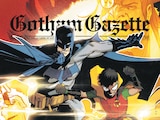Brainiac is having a moment in the world of DC right now. First, he was the very destructive big bad in Suicide Squad: Kill the Justice League. Now, he’s at the center of this month’s “House of Brainiac” Superman event. But what’s this guy’s deal? Where is a solid jumping on point for this famous Superman rogue? As usual, you have a number of solid options there, but I’ve always preferred Brainiac with his ‘90s goatee (Alex Jaffe can let you know what the deal is with that), and when you’re looking at that era, then you can’t go wrong with the Superman: Panic in the Sky storyline from 1992. Panic in the Sky has been collected as a trade, but those collections are no longer in print, so the easiest way to check it out is on DC UNIVERSE INFINITE.
The Premise:

It wouldn’t be a Brainiac story if he didn’t try to invade Earth at least once. The alien makes his descent on Earth, except this time, he’s bringing all of Warworld—a satellite feared across the entire DC cosmos—with him. It’s enough to unite both heroes and villains on Earth under Superman’s leadership, with some help from some of the New Gods as well. To challenge Brainiac’s invasion, Superman leads a team featuring the likes of Deathstroke (yes, you read that right), Wonder Woman, Blue Beetle, Booster Gold, Orion, Lightray, Nightwing, the Flash and more against Brainiac.
Let’s Talk Talent:

I don’t think I could ever exhaust myself talking about the strength of Superman books in the 1990s. Panic in the Sky is written by the iconic Dan Jurgens, Jerry Ordway, Louise Simonson and Roger Stern, who would all go on to write the earthshaking The Death of Superman storyline later that year. Jurgens also contributed art to the storyline, alongside Jon Bogdanove, Tom Grummett, Jackson Guice, Bob McLeod, Brett Breeding, Doug Hazlewood, Dennis Janke, Denis Rodier and Trevor Scott. The artists on Panic in the Sky included some of DC’s finest at the time. Doug Hazlewood also worked with Chas Truog and Grant Morrison on Animal Man, while Tom Grummett would later pencil Superboy, written by Karl Kesel.
Part of what makes ‘90s Superman so enticing is how he was drawn and written with such a commanding presence. Whether you’re a young kid stumbling onto these comics while flipping through your cousin’s shortboxes, or an adult revisiting this period in comics, you’ll likely notice that there’s a crisp athleticism to the art that remains striking all these years later.
A Few Reasons to Read:

- Deathstroke—let’s say that again, DEATHSTROKE—is disturbed by how callous Brainiac acts towards civilian lives in this story. Brainiac makes Slade look as virtuous and compassionate as Wonder Woman in comparison. Not an easy feat!
- The New Gods are in this story. For a period of time in the 1980s and 1990s, a story’s seriousness was often illustrated by involving the New Gods—beings from beyond the known universe who could quite literally enter Earth with a boom. New Gods like Metron, Lightray, Orion (the son of Darkseid who fights for good), Mister Miracle and Big Barda all play a role in Panic in the Sky. You know things are about to get serious if the New Gods pop in and express their concerns!

- Speaking of the New Gods, there’s a great cross-section of the DC Universe in this story. There’s someone for everyone on Superman’s team, whether it’s Doctor Fate, Aquaman, the Green Lantern Kilowog, Shazam, Fire and Ice, the Forever People, or the Metal Men. It’s a Crisis-level lineup without the baggage of being a Crisis-level story.
- The story is also a great primer for how Warworld fits into existing Superman lore. Warworld is most closely associated with the villain Mongul, but Panic in the Sky shows how flexible it is within the rest of Superman’s rogues gallery. If you want a modern take on an old part of Superman lore, then Panic in the Sky is the story for you.
Why It’s Worth Your Time:

While Brainiac’s fate in “House of Brainiac” remains to be seen, we can at least look back on how the Man of Steel has defeated him in the past. Since Panic in the Sky clearly doesn’t end with killing Brainiac (what kind of Superman story would that be, anyways?), there is much to be learned from Superman’s past clashes with this alien. What might “House of Brainiac” do that we haven’t already seen in stories like Panic in the Sky?
Superman: Panic in the Sky is a whirlwind of a story, but it’s got plenty of moments that get at the heart of its heroes. Whether it’s Guy Gardner calling Shazam “Captain Whitebread” or the Flash mumbling that he’s starving for a hamburger, Panic in the Sky strikes a rare balance by utilizing dozens of characters while still tailoring the story to their personalities. In this sense, it exemplifies why fans love the DC Universe so much. It isn’t necessarily one hero or character that drives their interest, but rather how each individual fits within the broader tapestry. It’s the relationships between characters, places, and concepts that makes it all feel special, and there’s hardly a better example of it—and the menace that Brainiac presents to the DCU—than Superman: Panic in the Sky.
Superman: Panic in the Sky can be read in full on DC UNIVERSE INFINITE.
Jules Chin Greene writes about comics for DC.com, and his work can also be found at Nerdist, Popverse and Multiverse of Color. You can follow him on Twitter and Bluesky at @JulesChinGreene.
NOTE: The views and opinions expressed in this feature are solely those of Jules Chin Greene and do not necessarily reflect those of DC or Warner Bros. Discovery, nor should they be read as confirmation or denial of future DC plans.















